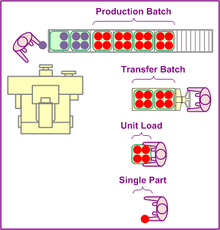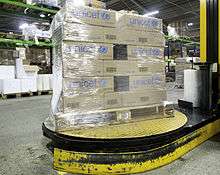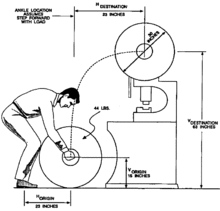Material handling
_load_stores_from_the_pier_to_the_ship_prior_to_getting_underway_from_Naval_Station_Norfolk.jpg)
Material handling involves short-distance movement within the confines of a building or between a building and a transportation vehicle.[1] It utilizes a wide range of manual, semi-automated, and automated equipment and includes consideration of the protection, storage, and control of materials throughout their manufacturing, warehousing, distribution, consumption, and disposal.[2] Material handling can be used to create time and place utility through the handling, storage, and control of material, as distinct from manufacturing, which creates form utility by changing the shape, form, and makeup of material.[3]
Role of material handling
Material handling plays an important role in manufacturing and logistics, which together represent over 20% of the U.S. economy.[4] Almost every item of physical commerce was transported on a conveyor or lift truck or other type of material handling equipment in manufacturing plants, warehouses, and retail stores.[5] While material handling is usually required as part of every production worker's job, over 650,000 people in the U.S. work as dedicated "material moving machine operators" and have a median annual wage of $31,530 (May 2012).[6] These operators use material handling equipment to transport various goods in a variety of industrial settings including moving construction materials around building sites or moving goods onto ships.
Design of material handling systems
Material handling is integral to the design of most production systems since the efficient flow of material between the activities of a production system is heavily dependent on the arrangement (or layout) of the activities. If two activities are adjacent to each other, then material might easily be handed from one activity to another. If activities are in sequence, a conveyor can move the material at low cost. If activities are separated, more expensive industrial trucks or overhead conveyors are required for transport. The high cost of using an industrial truck for material transport is due to both the labor costs of the operator and the negative impact on the performance of a production system (e.g., increased work in process) when multiple units of material are combined into a single transfer batch in order to reduce the number of trips required for transport.[7]

The unit load concept
A unit load is either a single unit of an item, or multiple units so arranged or restricted that they can be handled as a single unit and maintain their integrity. Although granular, liquid, and gaseous materials can be transported in bulk, they can also be contained into unit loads using bags, drums, and cylinders.[8] Advantages of unit loads are that more items can be handled at the same time (thereby reducing the number of trips required, and potentially reducing handling costs, loading and unloading times, and product damage) and that it enables the use of standardized material handling equipment. Disadvantages of unit loads include the negative impact of batching on production system performance, the time spent forming and breaking down the unit load, the cost of containers/pallets and other load restraining materials used in the unit load, and the cost of returning empty containers/pallets to their point of origin.[9]

In-process handling
Unit loads can be used both for in-process handling and for distribution (receiving, storing, and shipping). Unit load design involves determining the type, size, weight, and configuration of the load; the equipment and method used to handle the load; and the methods of forming (or building) and breaking down the load. For in-process handling, unit loads should not be larger than the production batch size of parts in process. Large production batches (used to increase the utilization of bottleneck activities) can be split into smaller transfer batches for handling purposes, where each transfer batch contains one or more unit loads, and small unit loads can be combined into a larger transfer batch to allow more efficient transport.[10]

Distribution
Selecting a unit load size for distribution can be difficult because containers/pallets are usually available only in standard sizes and configurations; truck trailers, rail boxcars, and airplane cargo bays are limited in width, length, and height; and the number of feasible container/pallet sizes for a load may be limited due to the existing warehouse layout and storage rack configurations and customer package/carton size and retail store shelf restrictions. Also, the practical size of a unit load may be limited by the equipment and aisle space available and the need for safe material handling.[11]
Types of material handling

Manual handling
Manual handling refers to the use of a worker’s hands to move individual containers by lifting, lowering, filling, emptying, or carrying them. It can expose workers to physical conditions that can lead to injuries that represent a large percentage of the over half a million cases of musculoskeletal disorders reported in the U.S. each year, and often involve strains and sprains to the lower back, shoulders, and upper limbs.[12] Ergonomic improvements can be used to modify manual handling tasks to reduce injury. These improvements can include reconfiguring the task and using positioning equipment like lift/tilt/turn tables, hoists, balancers, and manipulators to reduce reaching and bending. The NIOSH (National Institute for Occupational Safety and Health) 1991 Revised Lifting Equation[13] can be used to evaluate manual lifting tasks. Under ideal circumstances, the maximum recommended weight for manual lifting to avoid back injuries is 51 lb (23.13 kg). Using the exact conditions of the lift (height, distance lifted, weight, position of weight relative to body, asymmetrical lifts, and objects that are difficult to grasp), six multipliers are used to reduce the maximum recommended weight for less than ideal lifting tasks.

Automated handling
Whenever technically and economically feasible, equipment can be used to reduce and sometimes replace the need to manually handle material. Most existing material handling equipment is only semi-automated because a human operator is needed for tasks like loading/unloading and driving that are difficult and/or too costly to fully automate, although ongoing advances in sensing, machine intelligence, and robotics have made it possible to fully automate an increasing number of handling tasks.[5] A rough guide to determine how much can be spent for automated equipment that would replace one material handler is to consider that, with benefits, the median moving machine operator costs a company $45,432 per year.[14] Assuming a real interest rate of 1.7%[15] and a service life of 5 years[16] for the equipment with no salvage value,[17] a company should be willing to pay up to
to purchase automated equipment to replace one worker.[18] In many cases, automated equipment is not as flexible as a human operator, both with respect to not being able to do a particular task as well as a human and not being able to be as easily redeployed to do other tasks as needs change.
See also
- Material handling equipment
- Automation
- Conveyor system
- Industrial robot
- Bulk material handling
- Warehouse
- Human factors and ergonomics
- College-Industry Council on Material Handling Education
- Automated storage and retrieval system
Notes and references
- ↑ Coyle, J.J. (1992). Management of Business Logistics. Mason, OH: South-Western. p. 308.
- ↑ "Material handling". MHI. Retrieved 2014-10-02.
- ↑ Apple, J.M. (1972). Material Handling System Design. New York: Ronald.
- ↑ Manufacturing 12.0% in 2014 ("Facts About Manufacturing". Nat. Assoc. of Mfg. Retrieved 2015-05-05.) and logistics 8.2% in 2013 ("Annual State of Logistics Report State of Logistics Report" (PDF). CSCMP. Nov 2014. Retrieved 2015-02-15.)
- 1 2 "Material Handling and Logistics U.S. Roadmap" (PDF). MHI. January 2014. Retrieved 2015-05-08.
- ↑ "Occupational Outlook Handbook". BLS. Retrieved 2015-05-14.
- ↑ Hopp, W.J. (2011). Factory Physics. Long Grove, IL: Waveland. pp. 318–327.
- ↑ Kulwiec, R.A. (1981). Basics of Material Handling. Charlotte, NC: MHI. p. 10.
- ↑ Sule, D.R. (1994). Manufacturing Facilities: Location, Planning, and Design. Boston: PWS. p. 249.
- ↑ Askin, R.G. (1993). Modeling and Analysis of Manufacturing Systems. New York: Wiley. p. 292.
- ↑ Kay, M.G. (2012). "Material Handling Equipment" (PDF). pp. 5–6. Retrieved 2014-10-02.
- ↑ "Ergonomic Guidelines for Manual Material Handling" (PDF). California Department of Industrial Relations. 2007. Retrieved 2015-05-15.
- ↑ Waters, T.R. (1994). Applications Manual for the Revised NIOSH Lifting Equation. Cincinnati, OH: Centers for Disease Control and Prevention.
- ↑ $31,530 median wage divided by 0.694, where wages represent 69.4% and benefits 30.6% of total labor cost ("Employer Costs for Employee Compensation". BLS. December 2014. Retrieved 2015-05-15.).
- ↑ Average U.S. rate from 2005-2009 ("Real interest rate". The World Bank. Retrieved 2015-05-15.).
- ↑ Average service life of Custom Software ("BEA Depreciation Estimates" (PDF). BEA. 2004. Retrieved 2015-05-15.), conservative assumption since software is a major component of automated equipment and has the shortest service life compared to other components.
- ↑ Conservative assumption that simplifies the analysis since any positive salvage value would increase the purchase cost estimate.
- ↑ Amount willing to pay is the present value of an annuity immediate.
Further reading
- Apple, J.M., 1972, Material Handling System Design, New York: Ronald.
- Bartholdi, J.J., III, and Hackman, S.T., 2014, Warehouse & Distribution Science, Release 0.96.
- Frazelle, E., 2002, World-Class Warehousing and Material Handling, New York: McGraw-Hill.
- Heragu, S.S., 2008, Facilities Design, 3rd Ed., CRC Press.
- Kulwiec, R.A., Ed., 1985, Materials Handling Handbook, 2nd Ed., New York: Wiley.
- Mulcahy, D.E., 1999, Materials Handling Handbook, New York: McGraw-Hill.
External links
- College Industry Council on Material Handling Education (CICMHE)
- European Federation of Materials Handling
- Material Handling and Logistics U.S. Roadmap
- Material Handling Equipment Distributors Association
- Material Handling Equipment Taxonomy
- Material Handling Industry